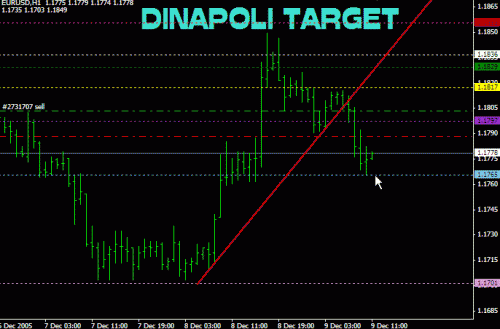ESignal Learning Trading Educator s Corner Joe DiNapoli
Post on: 18 Июнь, 2015 No Comment

Joe DiNapoli *
President of Coast Investment Software, Inc.
Focus: Although his methods are applicable across time frames and in all liquid markets, Joe is most noted for day trading stock market indices. He has been doing so since the S&P was born in 1982.
* Not employed by or affiliated with Interactive Data
A Methodology for Using the DiNapoli Preferred Stochastic and the DiNapoli MACD included in the eSignal Application
The methodology I am about to describe is designed to address the problem of entering a market with utmost safety and minimal risk. I believe the money in a trade is made upon proper entry. If you enter right, you’re likely not to be stopped out before it goes your way. If you enter in the right direction but at the wrong price, you’re gone before the market goes your way.
To set the stage for this unconventional trading strategy, certain assumptions must be agreed to about the way markets behave. If you don’t agree with the assumptions, the methodology will not make sense, and you should not use it. Also, I would expect anyone attempting to employ these strategies to have a minimum of one year of experience actively trading. A three-year minimum is preferred. You should also have a working knowledge of the conventional use of the Stochastic and MACD indicators.
The reason for this can be summed up by those of you old enough to have heard Jack Benny play the violin. He knew how to play the violin UNconventionally to get the results he wanted because he knew how to play the violin conventionally — very well.
The assumptions we will start with are:
- Markets are in run-away trends infrequently.
- Markets consist of a series of actions and measurable reactions.
- Buying or selling breakouts is a dangerous way to trade.
- Buying dips in an up trend and selling rallies in a down trend is a much safer way to trade.
- Using predefined profit objectives ensures a high percentage of winning trades.
If you agree with 1 and 2, you can see why points 3, 4 and 5 are valid.

Rules regarding the use of the DiNapoli Preferred Stochastic and DiNapoli MACD indicators (included in the eSignal application):
- I use the DiNapoli Preferred Stochastic and DiNapoli MACD as trend-defining tools only. I do not use them as overbought / oversold oscillators or momentum indicators. The DiNapoli Detrended Oscillator, also pre-programmed in eSignal, can be used for that analysis and is far more effective.
- An up trend signal in either indicator is given by the fast (blue) line penetrating the slow (black) line from below. A sell signal is given by the fast line penetrating the slow line from above. The position of the lines is unimportant in the scale of the indicators, but the angle of the penetration is significant. The sharper the angle, the closer to 90 degrees, the better for determining the quality of the subsequent trend. (See Chart 1.)
- eSignal has gone to considerable trouble to make available to you the correct formulas and numerical inputs to make these studies effective. Many years of development have gone into their development. Change them at your own risk.
The idea behind this pair of studies is pretty straightforward. The DiNapoli MACD is the strong trend-defining indicator, and the DiNapoli Preferred Stochastic, deliberately weakened, defines counter-trend rallies. As an example, take the down trend defined by the MACD as shown in Chart 1. The blue line does not penetrate the black line. Additionally, we have a rally as defined by the Stochastic. This rally takes place in the context of the down trend. The movement up is confined by a DiNapoli level (Fibonacci retracement level), where we are permissioned to sell because the MACD has maintained a down trend.
In practice, the DiNapoli Preferred Stochastic is a great aid in determining which retracement level to choose when initiating the entry. You can see that, even if the DiNapoli MACD slow line were penetrated slightly by the fast line, the angle of penetration would be nothing close to 90 degrees. As long as the retracement level holds the market, you can hold the trade. If the retracement level is penetrated but the down trend remains intact, you can still hold the trade!
Intel corp. is shown in Chart 2. The time frame is 30 minutes although all commonly used time frames will work. The method is also applicable to all liguid markets, Forex, equities, futures…you name it! Chart 2 shows two dips (buying opportunities). These were presented by traditional sell signals on the Preferred Stochastic while the DiNapoli MACD up trend remained intact.
Chart 3 is a 5-minute emini. Both buy and sell signals are shown using the same methodology. Researching the effectiveness of this approach in the past can be tricky because the study updates in real time, and what you see on a historical chart is the past with the study calculated on the close of the bar rather than every segment of the bar as it is built by each tick. Point A, for example, on the Preferred Stochastic gave a buy signal in real time.
The strategy becomes even more effective when one crosses time frames in markets that are thrusting and in which only shallow retracements are available.
You could, for example, sell all 5-minute DiNapoli Preferred Stochastic “traditional buy signals” when the half-hour DiNapoli MACD is pointing down on a sell. The possible combinations are almost endless, which is another plus of the methodology. You won’t be doing what your fellow eSignal user is doing unless he/she picks the exact time frames and retirements you choose to act on. Your stops will not be clustered because the stop loss is either a function of a more distant retracement, or the DiNapoli MACD in the time frame of your choice has gone against you. This, of course, assumes you can handle that risk according to money management parameters.
Once positioned in the trade, you should then choose an appropriate logical profit objective as typically defined by expansion analysis.
Booking profits while interacting with markets “safely” by hitting reactions appropriately within a trend is what this methodology is all about.
Disclaimer. The information contained herein is subject to change without notice and was obtained from sources believed to be reliable but is not guaranteed as to accuracy or completeness. Those using these materials for trading purposes are responsible for their own actions. No guarantee is made that trading signals or methods of analysis will be profitable or will not result in losses. It should not be assumed that performance will equal or exceed past results.
Joe’s Educator Credentials
Joe is a veteran trader with more than 35 years of solid market trading experience. He is also a dogged and thorough researcher, an internationally recognized lecturer and a widely acclaimed author. His foundation in electrical engineering and economics prepared Joe for exhaustive investigations into Displaced Moving Averages and the creation of his proprietary Oscillator Predictor. In particular, his practical and unique method of applying Fibonacci ratios to the price axis makes him one of today’s most sought-after experts.
Joe has taught his techniques in the major financial capitals of Europe, Asia, Russia, the Mid-East and South Africa, as well as in the United States. In 1996 alone, Mr. DiNapoli taught his techniques to capacity audiences in more than 23 financial centers around the globe. His articles, (including Leading and Lagging Indicators — Achieving a Balance and The X’d Trade. or Where’s My Fill ) have appeared in a wide variety of technical publications across the nation and worldwide. As president of Coast Investment Software, Inc. with offices in Bangkok, Thailand and on Siesta Key in Sarasota, Florida, Joe continues to develop and deploy high accuracy trading methods, using a combination of leading and lagging indicators in unique and innovative ways. He conducts a limited number of private tutorials each year at his trading room, and he also makes his trading approach available to others via software and trading course materials.














